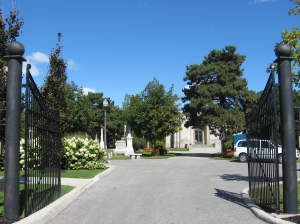By Lisa Terech, Community Engagement
Throughout the summer, the Oshawa Museum has been offering guided tours of Union Cemetery, Oshawa’s largest cemetery. We are grateful to our partners at Union Cemetery and the City of Oshawa for this collaboration. The tours have been geographic (exploring a certain section) and thematic (looking at a topic or theme and telling stories related to it).

While extensive research goes into writing the tours, and while I feel I have a good grasp of our community’s history, inevitably, I’m asked questions that I cannot answer! It happens on every outreach tour I have delivered, and I’m thankful for it because with every question I have to seek answers for I, in turn, learn and find new discoveries.
Our Weekly Union Cemetery Tours aren’t the only cemetery programs we’ve planned for 2018. Our popular Scenes from the Cemetery, dramatic tour, is returning on September 8 & 9. For more information on this event, please visit our website: scenesfromthecemetery.wordpress.com.
Here is a sample of the questions I was asked and couldn’t answer off the top of my head.
Was Alexandra Luke related to another prominent Oshawa family named Luke?
Alexandra Luke was descended from Oshawa’s other Luke family as well as the Ritson family. She was born in Montreal and her family settled in Oshawa in 1914; her father was J. Herbert Ritson Luke, and her paternal grandparents were Jesse Pascoe Luke and Mary Ritson. Her parents and paternal grandparents are buried in Union Cemetery. Luke is resting inside the Mausoleum with his husband, Ewart McLaughlin (the son of George McLaughlin). Alexandra Luke is notable because she was a Canadian abstract painter and member of Painters 11.
Do we/why don’t we talk about the Wolfenden family on tour? Their monument is located in South Presbyterian.
The Wolfenden family were early grave carvers in Whitby. Because they are based in Whitby, we do not collect these stories, however, our Executive Director has undertaken extensive research into early gravestone motifs and markers. Perhaps, because of her interest, she may explore them and other local businesses in a future blog post!

When was Thornton Road named?
This question is a little difficult to answer because it was part of East Whitby Township, and our records for the township aren’t nearly as extensive as for the City of Oshawa. We can best date street names by looking at City Directories, but the township isn’t always captured in these. The first directory we saw with Thornton Road listed in 1951.
While on the topic of Rev. Thornton, where was his house located?
It was located near the eastern boundaries of where Union Cemetery is today.
When did crematoriums start in the area?
The first crematorium in Canada was in Montreal at the Mount Royal Cemetery; Mount Pleasant was the first in Ontario who started in 1933.
What do oak leaves on headstones represent?
Strength, endurance, a long life.
Why were the Nursing Sisters called ‘Sisters’?
Nursing Sisters were called as such because some of the earliest nurses belonged to religious orders.
We were asked if Richard and Mary (Robinson) Mothersill were of any relation to the Mothersills who had a photo business in Oshawa in the 1970s, and it turns out they were. Mary was the daughter of John & Ruth Robinson, namesakes of Robinson House.








